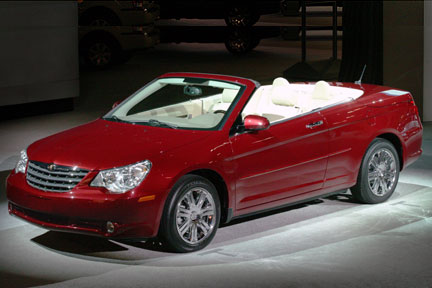Alternative fuels like ethanol could reduce our dependence on imported oil and reduce pollution. Ethanol, or ethyl alcohol, is already in everyday use. You are likely to be using it in your vehicle.

|
| California Governor Arnold Schwarzenegger introduces this E85-capable Chevrolet Tahoe at the 2006 Greater Los Angeles Auto Show. GM currently has more than 2 million flex-fuel vehicles on the road. |
First, small amounts of ethanol is now the oxygenate used in reformulated gasoline (RFG) to reduce pollution smog-forming and toxic air pollutants. MTBE (methyl tertiary butyl ether) has been ruled out since being detected in ground water. You probably are using ethanol if you add the contents of a can of 'octane booster.'
Next, there gasohol, a blend of 10-percent ethanol and 90- percent gasoline (E10), sold during the 1970's fuel shortages. E10 is back with states like Missouri, Minnesota, Montana, and Hawaii requiring its sale and others states planning to do so. The goal is the availability of at least E10 everywhere by 2010. There is move to increase this to E20 that contains 20-percent ethanol.
If you own an older vehicle, one built before the mid-1980s, you are more likely to experience problems with even small amounts of alcohol, even E10. A big problem is deterioration or swelling and hardening of rubber components like fuel hoses, carburetor seals and gaskets, and fuel pump seals. when in contact with ethanol. This may lead to fuel leaks. The solution is replacement of components with ethanol compatible ones. Trying to find and use non-ethanol fuel will be difficult.
Because ethanol absorbs water more readily, this can be especially troublesome with vehicles that sit idle for extended periods. It can cause rust in metal components such as fuel tanks. It can also cause pitting of metal parts. If you plan to store a vehicle, run the tank dry before storing.
While not usually a problem in vehicles, even low concentrations of ethanol can damage fiberglass fuel tanks such as used in boats. Ethanol dissolves the lining of fiberglass fuel tanks, often depositing a dark "sludge" inside marine engines causing costly damage. Eventually, fiberglass tanks dissolve until they fail, leaking fuel.
Finally, there is E85, 85-percent ethanol and 15-percent gasoline. Gasoline is needed in E85 to overcome starting problems because it is difficult to initiate combustion in pure ethanol especially in cold weather, meaning hard starts. E85 is used in Flexible Fuel Vehicles or FFVs that can operate on E85, gasoline, or any combination of the two.
About five-million E85 capable vehicles have been sold in the U.S. Recently, U.S. automakers announced they will double production of FFVs by 2010, or about two million annually. Unfortunately, there are only about 1000 E85 dispensing stations in the entire U.S. mostly in corn producing states. Thus, a very small percentage of FFVs ever have E85 in their tanks.
Modifying an engine to operate on E85 is pretty simple - add a fuel sensor to detect the ratio of E85 to gasoline, replace fuel system components that are not compatible with the more corrosive ethanol and reprogram the engine management computer to account for the varying blend of gasoline and ethanol that can range between all gasoline and all E85. The amount of gasoline and E85 is determined by the oxygen sensor based on the fact that E85 contains more oxygen than gasoline.

|
| The all-new 2008 Chrysler Sebring Convertible is a flexible fuel vehicle (FFV).(DaimlerChrysler Photo) |
While these modifications are simple, they are required to use E85. Unlike E10, or even E20, E85 should not be used in other than engines designed to operate on E85. If you accidentally refuel a non-FFV with E85 once, probably no damage will be done. But don't it often because of the damage it can do fuel system components. The CHECK ENGINE light will probably come on because of the higher oxygen content detected.
You will not probably notice any performance difference between E85 versus gasoline. While ethanol produces less energy than gasoline, it has a much higher octane rating (100 to 105). E85 contains only about 70-percent of the energy when compared to gasoline. This results in a 5- to 15-percent decrease in miles-per-gallon, depending on vehicle and driving conditions.
Because of potential problems with ethanol in old cars and trucks, vintage vehicle insurer, Hagerty, now has a new web site www.hagerty.com/ethanol, to address the growing concerns over ethanol-blended fuels and their possible effects on collector vehicles. The web sites provides information on how to protect vehicles from potential harm and where to find ethanol-compatible replacement parts. Site visitors can post their experiences with ethanol-based fuels and suggest possible solutions.




